Research Topics
It combines research, research training and education of young researchers in three fields:
- Elementary Particle Physics (Theory and Experiment)
- Astroparticle Physics (Theory and Experiment)
- Advanced Technologies
The research topics in these three fields are given below. In each of the topics various PhD theses are possible.
Cosmic Rays
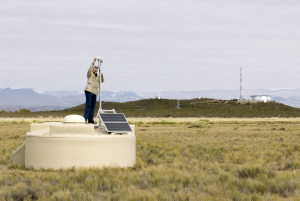
The Pierre Auger Observatory covers an area of 3000 square kilometres in the Argentine Pampa with more than 1600 autonomous tanks: In highly pure water, energetic particles produce light flashes. In addition, four stations with 27 telescopes at the edge of the detector field observe the light tracks of cosmic particle showers. Underground muon detectors and an array of radio antenna stations complete the experimental set-up.
At lower energies experimental efforts in measuring cosmic rays were performed by the experiment KASCADE-Grande on KIT’s northern campus. The data are still being analysed and prepared for public use via the web interface KCDC. Other activities in this research field concern cosmic ray measurements from space (JEM-EUSO) and in the Siberian taiga (TUNKA-REX) as well as the air shower simulation package CORSIKA.
KSETA PIs working in this field are Ralph Engel, Andreas Haungs, Tim Huege, Bianca Keilhauer, Matthias Kleifges, Frank Schröder, Markus Roth and Oliver Sander.
High-energy Neutrino Astronomy
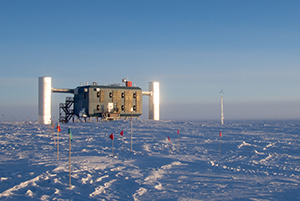
IceCube is the neutrino observatory located at the South Pole consisting of optical modules within a cubic kilometer of Antarctic ice. Neutrinos, as almost elusive particles, are great cosmic messengers possibly pointing to the extreme astrophysical sources and giving insight to processes involved in creating highest energy particles. The surface part of IceCube, IceTop, including 162 ice Cherenkov tanks, enables the study of cosmic-ray air-showers and acts as a veto for astrophysical events. Our group at KIT is mainly working in the frame of the next generation of the IceCube experiment, IceCube-Gen2.
KSETA PIs working in this field are Andreas Haungs, Ralph Engel, Tim Huege and Frank Schröder.
Dark Matter
We are conducting intensive research and development (R&D) for the current search for dark matter as well as for the next generation of experiments. The Dark Matter Group at KIT is a member of the XENON Collaboration which comprises 163 scientists from 28 institutions across 11 countries. The XENONnT experiment with an active xenon mass of several tons and a background that is expected to be lower by a factor 6 compared to XENON1T, thus improving even further the world-record sensitivity of XENON1T, has started ist commissioning phase in 2020.
We are also actively involved in the development of the follow-up experiment DARWIN, a future experiment for the direct detection of dark matter based on a multi-ton liquid xenon time projection chamber. KIT is a founding member of the DARWIN collaboration. We contribute e.g. to the electrostatic design of the TPC, on the suppression of background and on sensitivity studies for Dark Matter and other searches for physics beyond the Standard Model. The new ''Direct search Experiment for Light dark matter'', DELight, will be using superfluid helium as active target, instrumented with magnetic micro-calorimeters.
KSETA PIs working in this field are Kathrin Valerius, Klaus Eitel, Robert Ziegler, Felix Kahlhöfer and Thomas Schwetz-Mangold (theory and phenomenology).
Quantum Field Theory
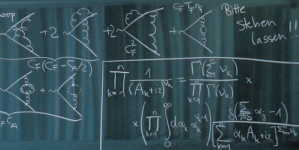
The fundamental building-blocks of matter, elementary particles, are described by the so-called Standard Model which provides information about their properties and the forces acting between them.
The research groups at KIT which work in theoretical particle physics perform complex perturbative calculations and non-perturbative considerations within the Standard Model or of hypothetical theories of New Physics in order to test the quantum nature of the theory and to extract fundamental constants of nature.
KSETA PIs working in this field are Anke Biekötter, Monika Blanke, Gudrun Heinrich, Kirill Melnikov, Margarete Mühlleitner, Ulrich Nierste, Matthias Steinhauser and Robert Ziegler.
Experimental Collider Physics
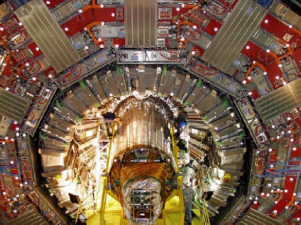
Teams from KIT conduct research at the world’s most powerful particle accelerators: the high luminosity electron-positron collider SuperKEKB at KEK laboratory in Tsukuba, Japan, and at the Large Hadron Collider at CERN, Switzerland.
At the LHC, which started operation in 2009, conditions are generated for reactions that took place about 10–12 seconds after the Big Bang. The CMS detector is one of four large detectors installed at the LHC to investigate these reactions. Teams from KSETA member institute ETP have contributed since 1995 to the construction and upgrades of the detector and to the data analysis. In 2012, this led to the discovery of the Higgs Boson, which is said to be responsible for the generation of mass. With this discovery, the Standard Model of particles and forces has been completed. The aim of the forthcoming runs is mostly to measure accurately the properties of the Higgs Boson and its interactions with other particles and to search for signs of physics beyond the Standard Model.
KIT is also active in R&D towards future experiments like SHADOWS at a new CERN beam-dump area, LUXE-NPOD at a proposed electron-photon collider at DESY, or future colliders like the FCC-ee.
KSETA PIs working in this field are Jürgen Becker, Ulrich Husemann, Günter Quast, Klaus Rabbertz, Oliver Sander, Roger Wolf, Thomas Müller, Markus Klute, Torben Ferber and Frank Simon.
Theoretical Collider Physics
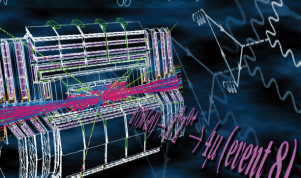
Information about the forces acting between elementary particles is obtained by experiments, in which particles are scattered at very high energies. Highest energies and, hence, smallest distances are reached at modern colliders, such as the LHC at Geneva. Theoretical collider physics makes predictions for these experiments and helps interpreting the data.
This research field is closely connected to the field "Quantum Field Theory" described above, because precise calculations and simulations based on our current understanding of the interactions of elementary particles are needed to provide predictions within and beyond the Standard Model, to be tested at collider experiments. The simulations include Higgs physics, top-quark and jet physics, electroweak physics, flavour physics and predictions for dark matter searches at colliders.
KSETA PIs working in this field are Anke Biekötter, Monika Blanke, Stefan Gieseke, Gudrun Heinrich and Felix Kahlhöfer.
Flavour Physics

Matter comes in flavours providing a rich spectrum of phenomena to be studied. Doing this with highest precision for processes, that the standard theory of particle physics suppresses or forbids, allows to find hints for physics beyond the known and for mass scales beyond any direct reach. Especially the subtle breaking of symmetries and processes with quantum loops are promising. But only if theoretical wit and experimental finesse are optimally combined to assemble the splintered and scattered hints to a full mosaic of the fundamental picture.
The Belle II experiment will take data with an integrated luminosity 1000 times that of its closest competitor LHCb.
KSETA PIs working in this field are Monika Blanke, Pablo Goldenzweig, Ulrich Nierste, Robert Ziegler and Frank Simon (experimental).
Neutrino Physics
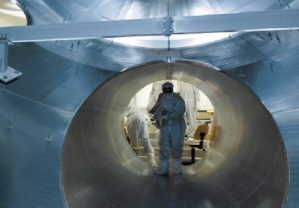
Neutrinos play a key role for our understanding of the Universe at the largest scales, as truly enormous numbers of neutrinos have been produced in the Big Bang. Their investigation touches and unifies fundamental questions of particle physics and cosmology.
To understand the role of these weakly interacting particles one has to measure the uncharted mass scale and mass hierarchy of neutrinos. The Karlsruhe Tritium Neutrino Experiment KATRIN will be the first worldwide to measure directly and in a model-independent way the mass of neutrinos with a sufficient sensitivity to determine their role as cosmic architects. But also in particle physics the neutrino properties like the mass scale measured by KATRIN provide unique access to extensions of the Standard Model of particle physics.
KSETA PI working in this field are Andreas Kopmann, Oliver Sander, Kathrin Valerius Sascha Wüstling, Sebastian Kempf, Magnus Schlösser and Thomas Schwetz-Mangold (theory and phenomenology).
Computational Physics (GridKa)
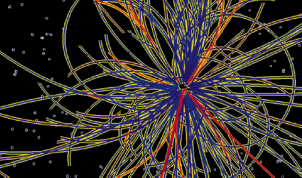
The research fields of particle and astroparticle physics are not feasible without the use of high-performance computers and distributed high throughput computing infrastructures, like the Worldwide LHC Computing Grid (WLCG).
GridKa at SCC, one of 12 Tier-1 centres of WLCG, is a major hub for computing and data distribution of all four of the LHC experiments as well as other HEP experiments and Auger. In addition to huge amounts of storage and archiving capacity and compute power, GridKa provides highly available Grid services used by the various experiment collaborations.
To optimize the use of computing and storage resources, KIT develops effective algorithms and optimized software to solve physical problems in particle and astroparticle physics. KSETA PIs working in this field is Achim Streit.
Technology Development
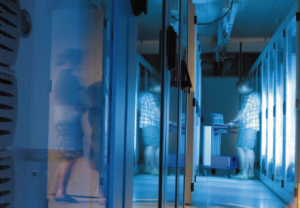
Already at the startup of the largest particle accelerator of the world, the LHC at CERN, Geneva, scientists of KCETA are working on the development of novel detectors for the next accelerator generation. It is aimed at increasing the resistance of the detector against radiation damage and at increasing the solid angle acceptance by using new cooling techniques.
For the KATRIN experiment unprecedented high vacuum systems and large superconducting magnet systems are designed and brought into operation. Locating the KATRIN experiment at KIT allows to make use of the unique expertise of the on-site Tritium Laboratory Karlsruhe (TLK), which is the only scientific laboratory equipped with a closed tritium cycle and licensed to handle the required amount of tritium.
The development of radio antennas for the detection of radio signals from air showers (LOPES) supports new promising options in the investigation of cosmic radiation. The method is optimized in prototype experiments.
We find refrigeration technology and cryotechnology in several of the research topics. They usually have the characteristic of an enabling technology in order to take advantage of special physical effects (e.g. supraconductivity)
KSETA PIs working in this field are Jürgen Becker, Beate Bornschein, Ralph Engel, Steffen Grohmann, Andreas Haungs, Bernhard Holzapfel, Tim Huege, Bianca Keilhauer, Matthias Kleifges, Andreas Kopmann, Ivan Perić, Markus Roth, Oliver Sander, Sascha Wüstling, Sebastian Kempf, Torben Ferber, Frank Hartmann, Ulrich Husemann, Markus Klute, Magnus Schlösser and Frank Simon.
Accelerator Research at KARA

On the area of the Karlsruhe Institute of Technology, the Synchrotron Radiation Facility KARA is located in a hall of 5000 m2. There, electrons are accelerated in a storage ring to the energy of 2.5 GeV.
KARA is equipped with beamlines, which offer facilities for analytical research with synchrotron radiation in the spectral region between infrared/Terahertz and hard X-ray energies. Activities include hard X-ray lithographic microstructuring, spectroscopy, microscopy, diffraction, and imaging.
The KARA Accelerator Group is responsible for operation, maintainance and development of the KARA accelerator complex. This complex consists of the storage ring and its injector chain: e-gun, microtron and booster synchrotron. The Accelerator Development Program covers a variety of topics from the fields of single and multi-particle beam dynamics and optics. It includes design and study of new lattices for the storage ring as well as studies of new modes of operation like the dedicated low alpha mode for the production of short bunches.
KARA also offers a linac-based accelerator test facility called FLUTE.
KSETA PI working in this field are Andreas Kopmann, Anke-Susanne Müller, Oliver Sander and Frank Simon.
Sensor Technologies and Detector Systems

Advances and scientific progress in the field of elementary and astroparticle physics are very often driven by the development of new sensor technologies and detector systems. In this context, the continuous further development of existing detector systems as well as the development of completely new sensor technologies are indispensable and therefore lie at the core of the research activities of KSETA. Latest semiconductor technologies and advanced analog and programmable digital electronics are used to develop detector systems for future large-scale experiments. With these detectors, we aim to push space, time, and energy resolution limits. Efficient electronic readout systems are developed to manage ever-increasing data rates. Embedded intelligent trigger solutions enable coping with the data deluge of physics experiments. In KSETA an interdisciplinary team of engineers, computer scientists, and physicists is working in the field of detector systems development and covers a broad spectrum of technologies: sensor and readout electronics use application specific integrated circuits (ASICs), radiation-hard circuits, electronic packaging, silicon photonics for seamless integration of optical data transmission, massive parallel, distributed real-time data processing, signal processing, RF design technology, and finally commissioning, test and characterization for complex detector systems are required. In many areas of fundamental research, the resolution of "conventional" detector systems is not sufficient to tackle open questions with the necessary precision due to physical limitations. In these cases, superconductor-based quantum technologies are more frequently used. These type of sensors can often achieve resolutions that are orders of magnitude better compared to classical solutions. The activities in KSETA cover also for this type of sensors, operated close to the absolute temperature minimum, the full signal processing chain from the sensor, via readout by means of cryogenic multiplexing, to data processing and recording in real time.
KSETA PIs working in this field are Jürgen Becker, Sebastian Kempf, Andreas Kopmann, Ivan Perić, Oliver Sander, Sascha Wüstling, Torben Ferber, Ulrich Husemann and Frank Simon.
Software Defined DAQ

Novel instruments and detectors are key for future research in elementary particle physics and virtually all other scientific domains.
But these devices pose large challenges with their rapidly increasing data rates which far outpace the improvements in the performance of storage systems. It makes online data processing and reduction ever more crucial for the next generation of detector systems. The Software Defined Data Acquisition paradigm relies on HPC and Cloud resources to build more sophisticated data processing chains than what is currently possible with traditional approaches. The key research areas include low-latency networking, scheduling, and data flow management; parallel, heterogeneous, and approximate computing; parallel and quantum algorithms; advanced databases, workflow engines, and orchestration systems.
KSETA PI working in this field is Andreas Kopmann and Frank Simon.
Projects in preparation
The scientific topics are in constant development. This dynamic process is driven by scientific curiosity and the program cycles of the KCETA funding programs. Currently, multi-messenger astroparticle physics with cosmic rays, the intensified and extended search for dark matter in direct collision experiments and at accelerators, the development of astroparticle theory, the close linking of theoretical and experimental studies in the evaluation of LHC data and the use of grid computing are being discussed as possible new activities.

